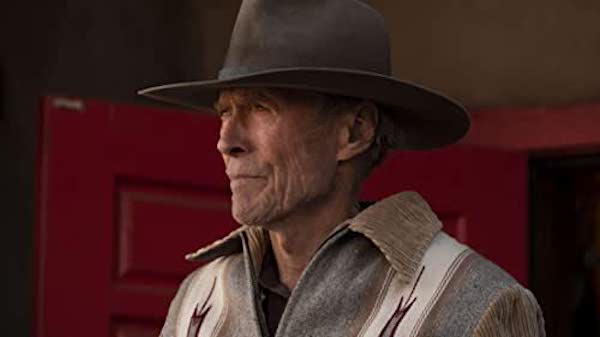Film Review: “Cry Macho” — Not So Mucho Macho
By Tim Jackson
Cry Macho is little more than nostalgia for the Old West of Hollywood.
Cry Macho, directed by Clint Eastwood. In wide release and streaming on HBO.

Clint Eastwood in Cry Macho.
In Cry Macho, Clint Eastwood directs and stars as Mike Milo, a Real Cowboy and gnarly retired horse trainer. A friend and former employer, Howard Polk (Dwight Yoakam) asks Milo for a favor: to rescue Rafa, Polk’s son (Eduardo Minett), from the nefarious grip of his alcoholic, philandering former wife, Leta (Fernanda Urrejola). She is living in Mexico on a lovely hacienda: it is unclear where the money to maintain the place comes from, but it can’t be good. There are sinister-looking henchmen lurking about. Leta claims the boy is unruly, but more likely she is the culprit. At one point, she tries to seduce Milo, who rejects her no doubt demanding advances. A wise choice, given that the actor is 91 years old.
Noble knight that he is, Milo heads off in search of the boy, who has run off to live on the streets away from the clutches of his mother. With little effort, he quickly finds Rafa at a cockfight. The title of the film refers (ironically) to Rafa’s prized pet, a rooster named for its prowess in these avian blood brawls. The old man grabs “the kid” and they hit the road with mother’s stooges in weak pursuit. Inspired by the stern snarl of Eastwood’s very weathered cowboy, Rafa learns the ways of manliness — including the fact that “macho” is way overrated. For a brief time they need to hide in a small town. Milo’s inner goodness is instantly recognized by a local barmaid with three adorable children — another opportunity for some nonagenarian romance arises.
The creaky script is from a novel by N. Richard Nash. The writer’s original screenplay was rejected by Hollywood for years. With the assistance of Nick Schenk, who also penned Eastwood’s Gran Torino and The Mule, the ancient script has been saddled up to serve as a star vehicle for Eastwood, who, once again, has fashioned a story that examines male culture through the lens of his own mythology. Unfortunately, the film’s clichés about becoming a man never rise above the level of an after school special.
This is a would-be character study with no character. The rescue and return plot is a lame excuse to highlight Milo’s transcendent dignity, not to examine what makes him tick. So Ben Davis’s lovely cinematography (Three Billboards, Guardians of the Galaxy) is wasted. Singer-songwriter Dwight Yoakam, who dependably plays country types, has hidden motives that, when revealed, are surprisingly anticlimactic. Urrejola, sexy and powerful in Narcos: Mexico, is reduced to playing a one-dimensional spicy Latina wench. It strains credulity that her hot temper would erupt after her attempts to seduce the 91-year-old cowboy come to naught. The boy, Eduardo Minett, has little to work with, delivering his dialogue with pedestrian listlessness. Even the rooster is exploited as a trite visual gag; at one point, the fighting cock is called into action as an unlikely weapon. Then there is Eastwood himself, growling and purring his lines out the side of his mouth. I am no ageist but, given his stiff gait, it is impossible to believe that Milo can mount and break in a wild horse. And it is pure geriatric fantasy that the oldster could level a young Mexican thug with a single punch.

Clint Eastwood and Eduardo Minet in Cry Macho.
Cry Macho is little more than nostalgia for the Old West of Hollywood. Its collection of routine character types, predictable plot points, and wooden acting might entertain fans of reruns of TV oaters, such as The Rifleman, Gunsmoke or Rawhide (Eastwood’s TV debut). The rest of us might see the film as an exercise in parody.
Why did this get made? As a director, Eastwood is known for his efficient directing style. He makes movies quickly, on time, and often under budget. He shoots fast and from the hip, but those hips have become more than a little stiff at this point. The point is, Eastwood’s films make money. So no suits will interfere with what he decides to film, projects that are based on decades of success as an actor of restrained cool and, at his best, a director of solid entertainments. At this point, it is time to “Cry Suficiente.”
Tim Jackson was an assistant professor of Digital Film and Video for 20 years. His music career in Boston began in the 1970s and includes some 20 groups, recordings, national and international tours, and contributions to film soundtracks. He studied theater and English as an undergraduate, and has also has worked helter skelter as an actor and member of SAG and AFTRA since the 1980s. He has directed three feature documentaries: Chaos and Order: Making American Theater about the American Repertory Theater; Radical Jesters, which profiles the practices of 11 interventionist artists and agit-prop performance groups; When Things Go Wrong: The Robin Lane Story, and the short film The American Gurner. He is a member of the Boston Society of Film Critics. You can read more of his work on his blog.

What People Think About Clint Eastwood’s Final Acting Performance…
https://aiptcomics.com/2021/09/21/cry-macho-clint-eastwood-dwight-yoakam/
https://www.reddit.com/r/movies/comments/pqdhau/official_discussion_cry_macho_spoilers/
The Inconvenient Truths About Clint Eastwood…
https://www.independent.ie/irish-news/clint-the-man-with-no-shame-26152887.html
https://www.nickiswift.com/242943/tragic-details-about-clint-eastwoods-ex-girlfriend/